Learn how to make this DIY juniper spice beard balm for that bearded person in your life! This is a terrific homemade beard balm made with all natural herbal ingredients. This juniper spice recipe beard balm smells amazing!
Homemade Herbal Beard Balm
Last year I made a Rosemary Pine Beard Balm that was hugely popular, so I thought I’d come up with a new and different one for this season.
The piney scent made it really wonderful, so I expanded on that theme by using fresh juniper cuttings and berries for this one, along with dried juniper berries, cinnamon, and cloves.
Beard balm helps to condition, soften, and style beards. The addition of herbs that are good for the hair and skin make them perfect for beard care, and they smell wonderful too!
Make the Juniper Infused Oil
{This post is sponsored by Mountain Rose Herbs}
The first step in making this homemade beard balm is to make a juniper berry infused oil with cinnamon and cloves.
I like to include some fresh juniper twigs and berries (learn about foraging for juniper berries here), but if you don’t have any juniper available in your area you can use cedar or any other conifer that you might have access to.
Related: How to Identify Conifer Trees: Pine, Fir, Spruce, Juniper & more
Put these spices into a pint sized jar:
- 2 tablespoons dried juniper berries
- 1 tablespoon cinnamon chips (or one cinnamon stick)
- 1 teaspoon whole cloves
Fill the rest of the jar with fresh juniper or other conifer twigs, leaving about an inch or so of space at the top of the jar. Then cover everything with the carrier oil of your choice.
When making beard balm, I like to use a blend of olive, coconut, sweet almond, and jojoba oils.
You don’t have to use all of those, but I definitely recommend using some jojoba oil as it is very nourishing for the beard.
Cover the jar and let it sit in a cool and dark place for 4-6 weeks to infuse, then strain out the solids with a cheesecloth or fine mesh strainer before use.
Make the Juniper Spice Beard Balm
Once your juniper oil is done infusing then you can make the beard balm!
This recipe makes about 6 ounces of beard balm total.
You will need a container (or containers) to keep it in. I used 2 ounce tins, which would make you three balms total (you can purchase tins from Mountain Rose Herbs).
Put the infused oil and beeswax into the top container of a double boiler, and stir as the beeswax melts.
(Tip: you can make a double boiler with a smaller pot, bowl, or glass pyrex measuring cup over an inch or so of simmering water. If you use glass pyrex, put something in the bottom of the pot that it can rest on, such as a canning jar lid).
Once the beeswax has completely melted, add the shea butter and stir until it dissolves.
When everything has liquefied, stir in the essential oils. Carefully pour the mixture into jars or tins.
Let them cool undisturbed for several hours. The beard balm will harden as it cools.
I am really happy with the way this beard balms turned out! It smells absolutely wonderful with a rustic hint of juniper and spices.
The addition of shea butter and jojoba oil will help to soften and hydrate the hair. It’s the perfect gift for any bearded man that you know!
Every bearded man needs his own homemade beard balm, and this one is easy to make and smells wonderful!
Happy homemade beard balm making!
Beard & Hair Care Recipes
Discover my other beard and hair care recipes! You can also see my post on DIY Herbal Gifts for Men!
Get more conifer needle recipes here: 30+ Conifer Needle Recipes: Drinks, Desserts, Syrups, Balms & More!
Juniper Spice Beard Balm
Ingredients
Juniper Infused Herbal Oil
- 2 tablespoons juniper berries
- 1 tablespoon cinnamon chips or 1 stick
- 1 teaspoon whole cloves
- juniper or conifer twigs
- 1 cup carrier oil of choice I like to use a blend of olive, coconut, sweet almond, and jojoba oils
Beard Balm
- ½ cup juniper infused oil
- ¾ ounce beeswax
- ½ ounce refined shea butter unrefined can be used, but will carry a scent
- 8 drops juniper berry essential oil
- 8 drops fir needle essential oil
- 4 drops cinnamon leaf essential oil
- 4 drops clove bud essential oil
Instructions
Juniper Infused Herbal Oil
- Put the juniper berries, whole cloves, and cinnamon chips into a pint-sized jar.
- Fill the rest of the jar with fresh juniper or other conifer twigs, leaving about an inch or so of space at the top of the jar.
- Cover everything with the carrier oil of your choice.
- Cover the jar and let it sit in a cool and dark place for 4-6 weeks to infuse, then strain out the solids with a cheesecloth or fine mesh strainer before use.
Beard Balm
- Put the infused oil and beeswax into the top container of a double boiler, and stir as the beeswax melts.
- Once the beeswax has completely melted, add the shea butter and stir until it dissolves.
- When everything has liquefied, stir in the essential oils.
- Carefully pour the mixture into jars or tins.
- Let them cool undisturbed for several hours. The beard balm will harden as it cools.
Notes
- I like to include some fresh juniper twigs and berries, but if you don’t have any juniper available in your area you can use cedar or any other conifer that you might have access to.
- When making beard balms, I like to use a blend of olive, coconut, sweet almond, and jojoba oils. You don’t have to use all of those, but I definitely recommend using some jojoba oil as it is very nourishing for the beard.
- Tip: you can make a double boiler with a smaller pot, bowl, or glass pyrex measuring cup over an inch or so of simmering water. If you use glass pyrex, put something in the bottom of the pot that it can rest on, such as a canning jar lid.

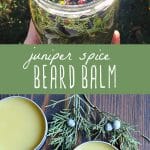
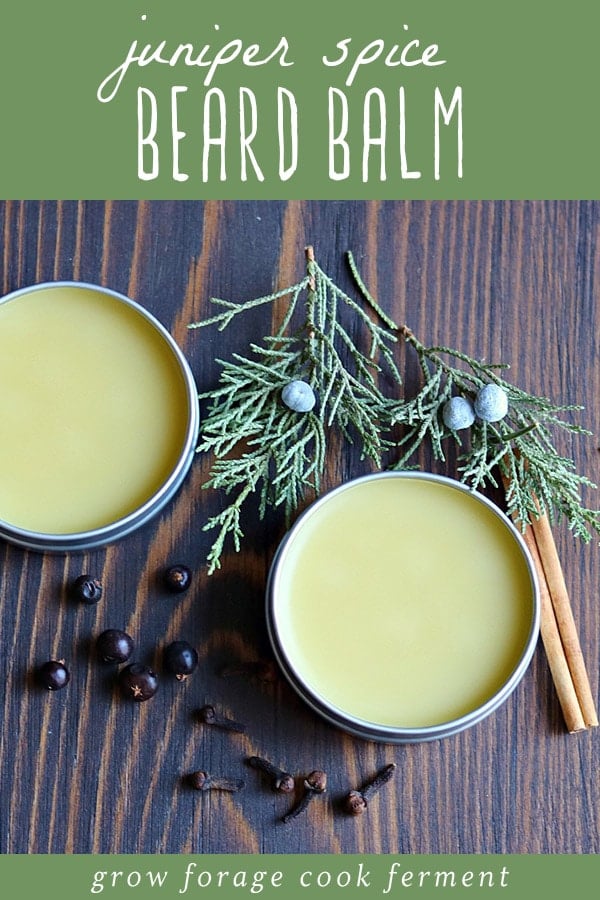
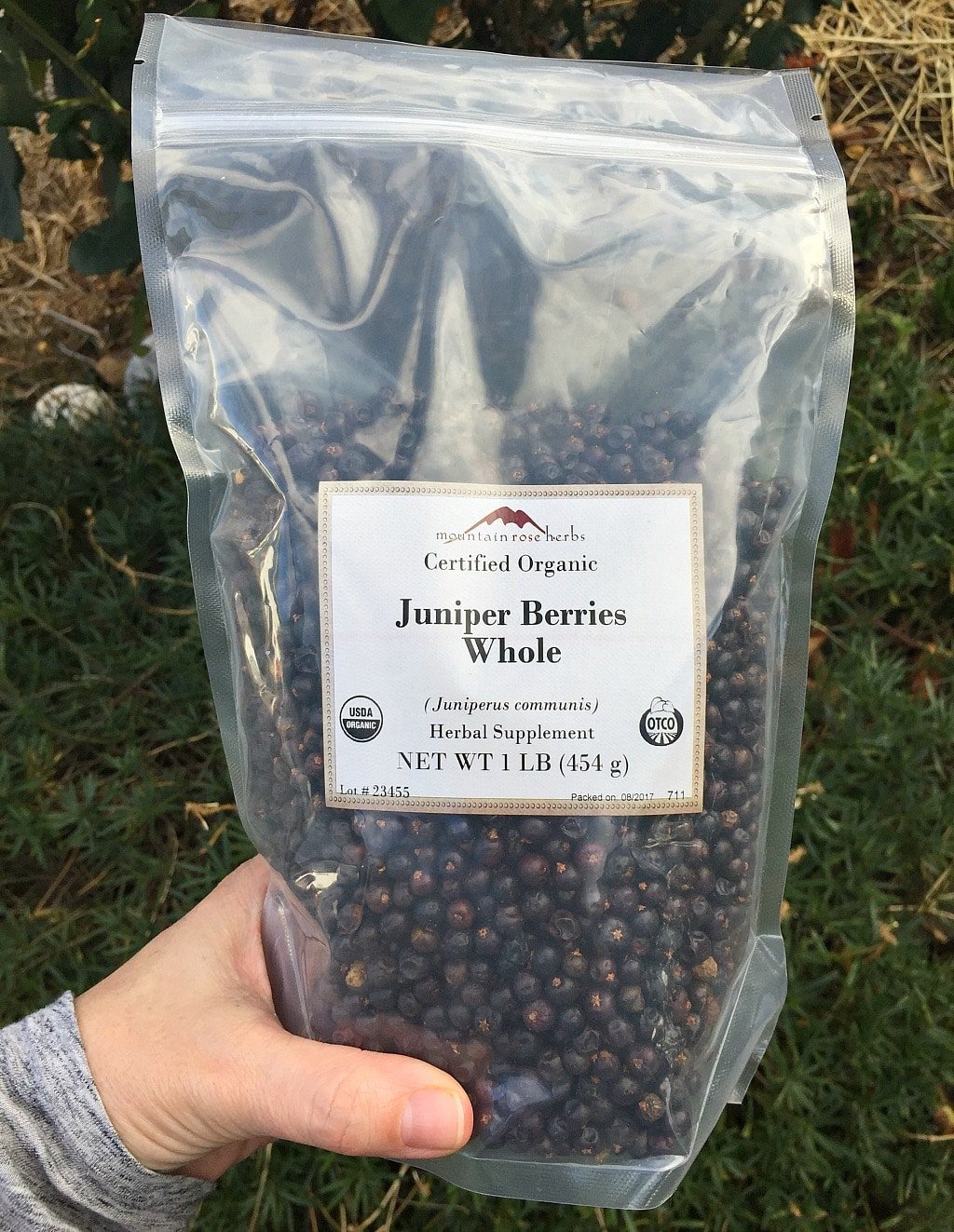
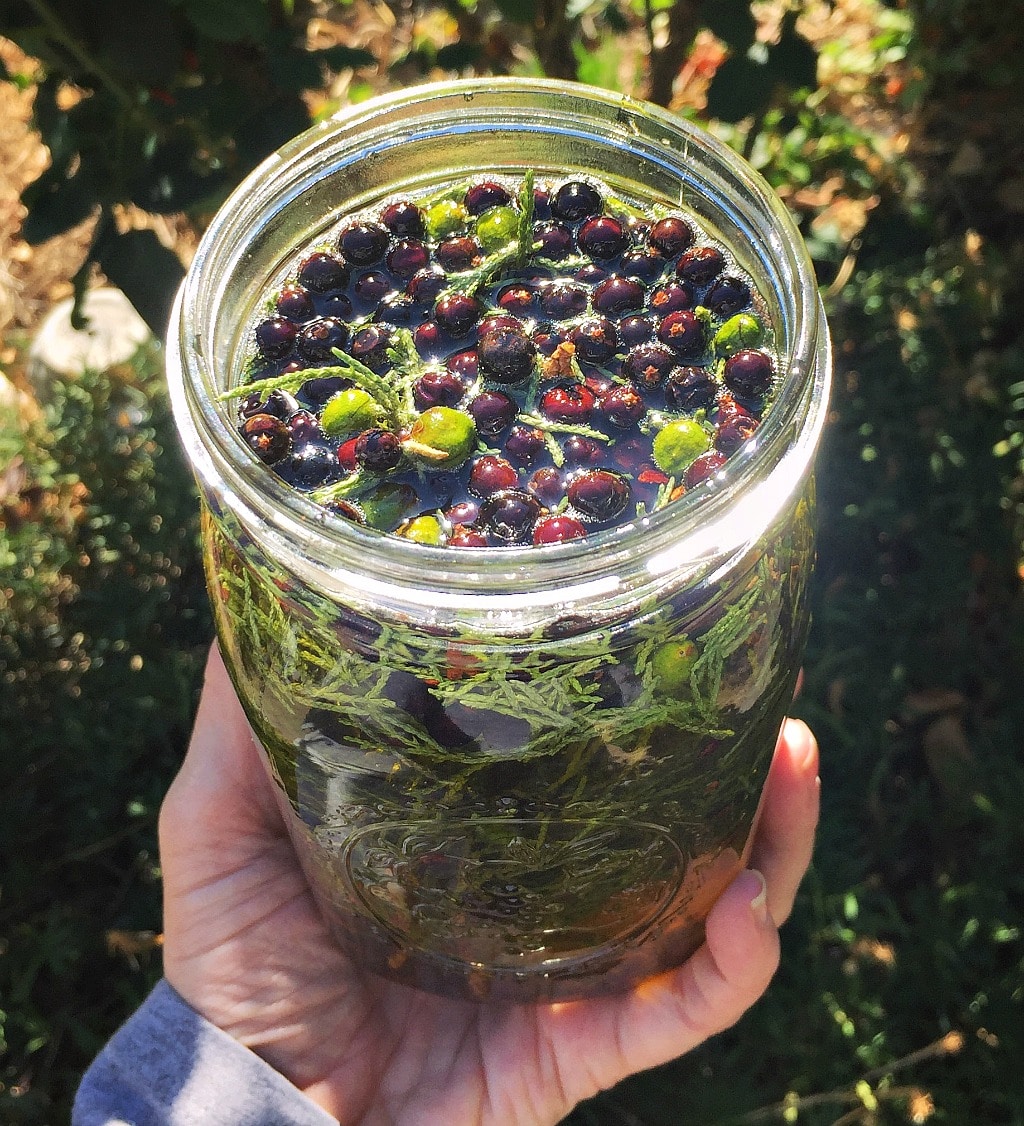
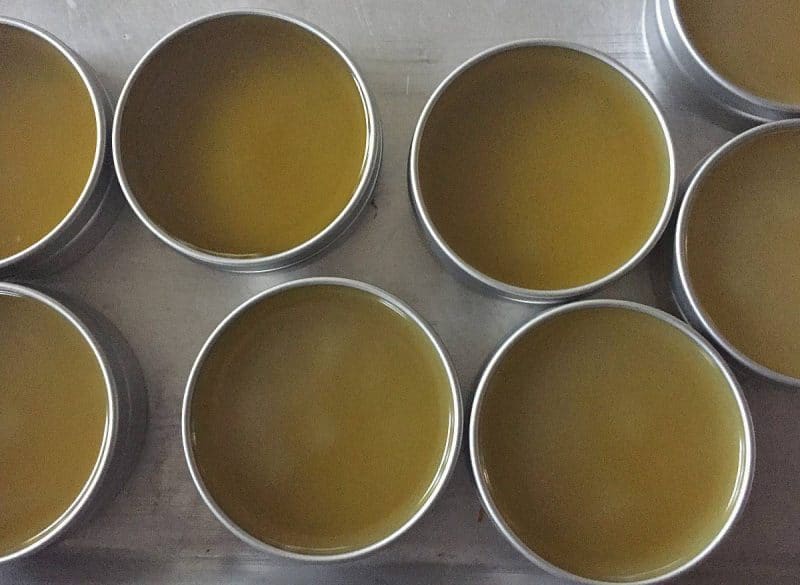
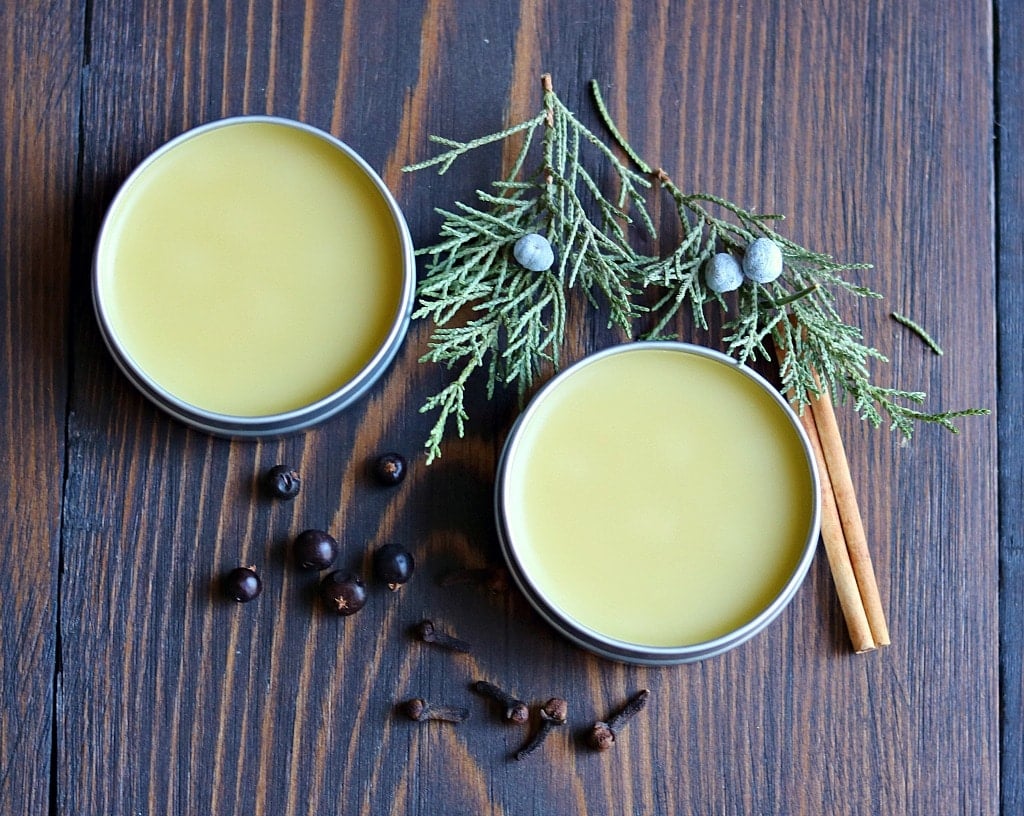
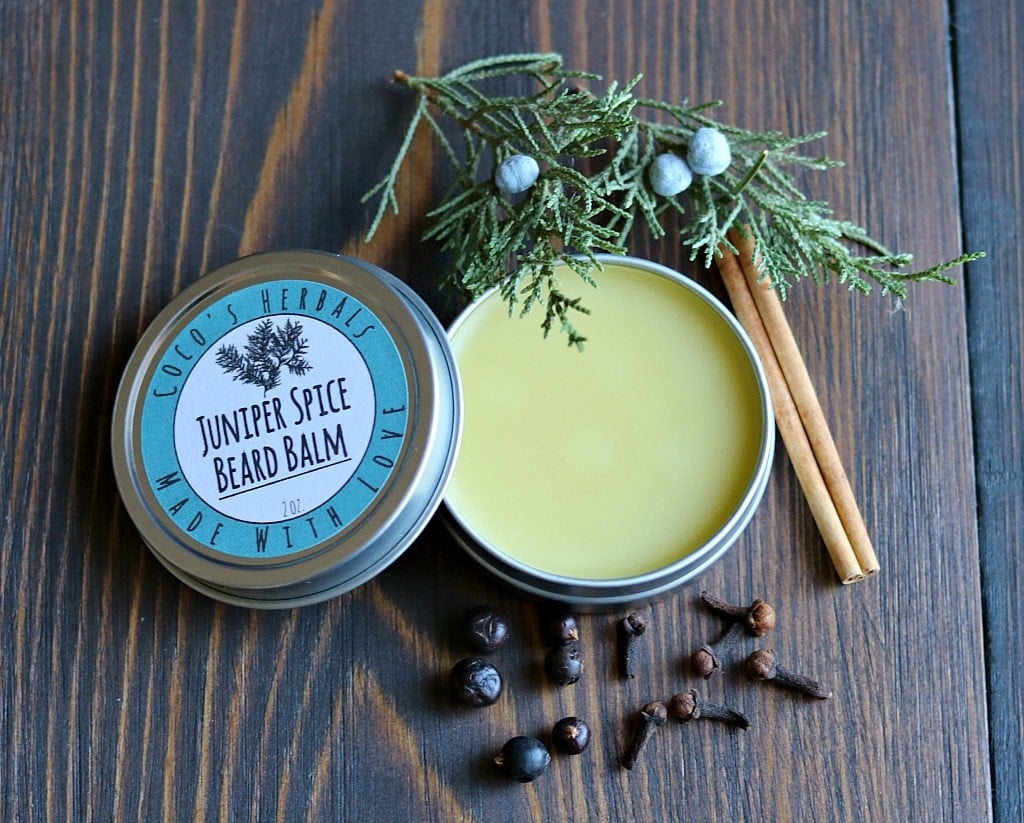
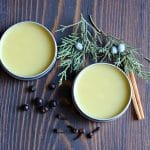

Hey there, will the moisture from the fresh juniper berries/twigs (fresh pine needles maybe) not make the oil go bad?
This recipe uses dried juniper berries and the twigs contain very little moisture content.
Blessings!
I made this recipe in the past, and my hubby adores it for his beard! As a curiosity, could the oil infusion be done in less than 4-6 weeks, say in 3-4 weeks? Obviously the infusion wont be as potent, but just a question – what is your experience on this, if any?
Thanks,
G
Hi Gabriella. Yes, you can let it infuse for less time, but like you said, it’ll be less potent.
I’d love to make this but my husband isn’t interested in either a balm or oil for his beard. What else can be done with the infused oil? It sounds like such a good-smelling combination. Thanks!
Hi Beth. You can use the infused oil in any other homemade skin care recipe or alone on your skin as a moisturizer.
Hello, I got a little confused with some of the directions and I’m hoping you can help. You said to infuse cinnamon, clove and juniper together in a jar. That part I understood. But as I began reading further you stated to add those oils separately. Can I use what I infused together or do I need to put each one: clove, juniper, and cinnamon in it’s own separate jar to infuse?
Thank you so much for taking the time to write this article and share this recipe.
Hi there. Yes, that’s correct. The juniper berries, whole cloves, and cinnamon are all infused together.
Should I wash the yeast off my Juniper cones before adding them to the pint?
You can if you prefer, but it’s not necessary.
Excited to make this. How many tins (1oz) does this recipe make. Thank you
Sorry, I now see it yields 6oz.
Hi I was wondering if you could just use sunflower oil? My husband has a hard time with different oils so far sunflower has worked the best for him.
Yes, that should still work!
Is there a way to make a matching beard oil in scent?
Yes, just use the infused oil portion as a beard oil!
What is your carrier oil blend recipe? I will be making this for Christmas gifts, using beeswax from my hives.
This is a real nice combinations of oils and scents. I use the left over infused oil on my dry skin after a shower. The balm is a hit also.
What are some common yet workable alternatives to Shea butter? Can’t find that in the country I’m living in now.
What’s the point of infusing an oil with botanical materials if you’re just going to add the same essential oils at the end? Isn’t that just six extra weeks for the sake of redundancy? Or does an infused oil have different properties than the same essential oil?
The essential oils are to enhance the scent to make it stronger, but they aren’t necessary. Whenever I make salves or balms, I generally like to infuse the oil with the whole plant material, then add essential oils as needed for aroma. There is definitely some benefit to using the whole plants over just essential oils!